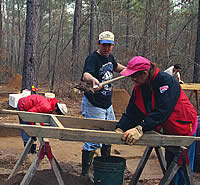
Crew members sift shovelfuls of sediment
from the excavation block, searching for small artifacts
such as beads, bone, or sherds.
Click images to enlarge
|
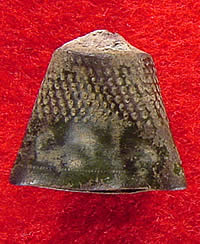
Thimbles were frequently traded to
Native Americans who perforated them for use as decorative "tinklers" on clothing, particularly dance
costumes. The two found at Sha'chahdínnih were
unusually small, perhaps manufactured specifically as
trade items.
|
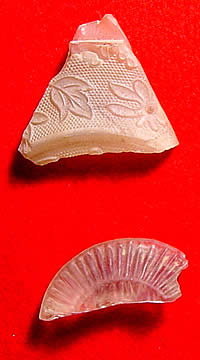
Examples of pressed glass.
|
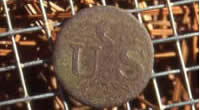
A brass military button made between
1827 and 1839. Such buttons were used on military coats
that were often presented as gifts to Indian tribal
leaders. Click to see sketch of detail.
|
|
Notches were cut along the edge of
this pewter spoon handle, creating a serrated tool effective
for cutting or fish scaling. The stamped mark, "Yates,"
indicates the spoon was manufactured in Birmingham,
England, between 1810 and 1840.
|
|
"It can now be said incontrovertibly that
Sha'chahdínnih (Timber Hill) has been found,"
Parsons and Bruseth wrote after the excavations were over
and the analyses complete. How could the archeologists be
so sure? The six days of excavation had netted a mere 1,307
artifacts—including hundreds of thumbnail-sized pottery
sherds—a small number, even for such a brief excavation.
The archeologists were certain about the site's identity because
the artifacts confirmed the information gleaned from historical
documents and maps. Step by step, 10-cm level by10-cm level,
they had to put together the last pieces of the puzzle.
First they had to establish that the site was
occupied by Caddo people, and not just any Caddo people, but
members of the Kadohadacho families who lived during the right
time period. What was their evidence?
- Most importantly, the site is in the exact
location shown on the most detailed of the historical maps,
and the artifacts show that the village was occupied during
the time when the Kadohadachos are known to have been at
Timber Hill.
- A number of the artifacts recovered demonstrated
that the occupation of the site was by Native Americans
rather than early Euro-American settlers. These included
a conical metal arrowpoint, silver ornaments, glass beads,
thimbles perforated for use as tinklers on clothing, a hawk
bell used in a similar manner, a spoon handle modified for
use as a scarifier or fish scaler, and sherds of glass with
edges flaked to make cutting and scraping tools.
- The decorations on pottery sherds were similar
to those found at other historic Caddo sites in the region.
In a sizable proportion of the pottery sherds (41 percent),
shell was used as a tempering agent, as opposed to crushed
bone, for example, or sand. A tempering agent is a solid
material added to the moist clay to improve structure and
reduce shrinkage during drying and firing. A large percentage
of the pottery from the Kadohadacho homeland in the Great
Bend of the Red River is also tempered with shell, but shell
temper is uncommon in ceramics from other Caddo sites near
Timber Hill. This provided some evidence that the Timber
Hill people were originally from the Kadohadacho homeland.
How did the archeologists know the artifacts
were remnants of life from the brief period 1800-1840, when
the Kadohadachos lived at Timber Hill? Most were of European
or Euro-American manufacture, though the villagers had modified
some of them to suit their own purposes. So the site was clearly
occupied after the Caddos had extensive contact with European
settlers. Even more telling, the manufacturing dates of some
artifacts could be determined with a fair amount of precision.
The handle of one pewter spoon could have been manufactured
only between 1810 and 1840, for example, and a piece of English
pottery bore a maker's mark used only from 1834 to 1836.
Especially interesting was a military button
made between 1827 and 1839. Military coats were common gifts
to Indian leaders, and Sibley wrote of such a presentation
at an 1807 meeting in Natchitoches, Louisiana, with Chief
Dehahuit and another Caddo official:
I gave the Caddo Chief a Scarlet Regimental
Coat trim'd with Black Velvet and white Plated Buttons.
At the same time gave the Son of Carody the Old Caddo Chief
a Blue Half Regimental Coat trim'd with Scarlet and a White
Linnen Shirt.
The archeologists noted that this meeting occurred
in 1807 and the button was manufactured later, but it was
likely that the presentations continued and that the recovered
specimen was from such a gift.
|
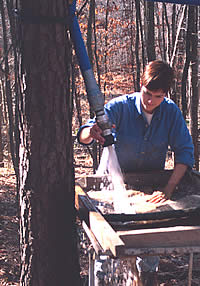
Tracy Smith uses a water hose draped
from a pine branch to quickly dissolve sediments and
speed up the screening process.
|
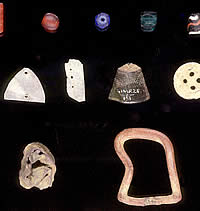
Jewelry and clothing items. Top row, glass beads, probably once
strung in necklaces; middle row, silver ornaments, a
brass thimble tinkler, and a white metal button; bottom,
a crushed brass hawk bell, worn on clothing to produce
a musical sound during dancing, and a brass buckle frame.
|
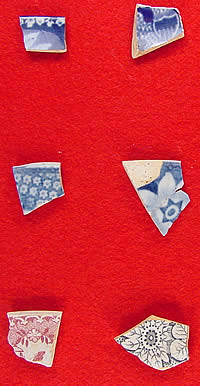
Sherds of early 19th-century European
transfer-ware ceramics found at the site. Top row, Quebec pattern; middle, Lions
pattern; bottom, red, black and overpainted transfer
ware. View examples of complete Quebec
or Lions
pattern vessels (not from present site). |
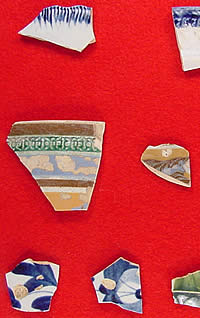
Fragments of edge-decorated wares
(top), banded slipwares (middle), and hand-painted wares
(bottom).
|
|